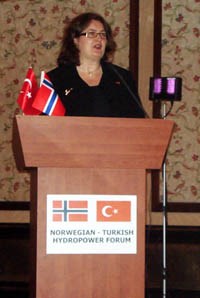Hydropower Seminar, Ankara 26 November 2008
Historical archive
Published under: Stoltenberg's 2nd Government
Publisher: Ministry of Petroleum and Energy
Speech/statement | Date: 05/12/2008
Opening Address by HE Liv Monica Stubholt, Deputy Minister of the Royal Norwegian Ministry of Petroleum and Energy
 Your Royal Highness, Excellencies, distinguished guests, ladies and gentlemen,
Your Royal Highness, Excellencies, distinguished guests, ladies and gentlemen,
It is a great pleasure for me to address you at the opening of this high-level seminar. On behalf of the Ministry of Petroleum and Energy I thank our co- organisers; the Turkish Ministry of Energy, the Norwegian Embassy and Innovation Norway
We are all very honoured to have His Royal Highness Crown Prince Haakon with us at the opening. This is a clear sign of the importance of hydropower for Norway.
I have noted that Turkey is well known as a strong dam builder. In addition, Turkey and Norway have in common that we are the two countries in Europe with the largest hydropower resources.
Yesterday, the Crown prince was asked how Turkey can become rich like Turkey. There is no given recipe and no two countries are alike. But natural resources play a part.
It was hydropower – not petroleum – that turned Norway from being an agricultural society one hundred years ago into an industrialised country. In addition we have developed a strong legislative framework governing the production of hydropower and the distribution of the benefits created. This has served us well for 100 years.
Natural resources
Water is one of Norway’s major natural resources together with oil and gas. Norway is Europe’s largest producer of hydropower, and the 6th largest in the world.
Our abundance of water allows us to produce our electricity almost exclusively from this clean and renewable resource.
99 per cent of Norway’s electricity production is based on hydropower, with the last per cent being wind power. Large reservoirs secure the production during cold and dry winters. Close to 50 per cent of the reservoir capacity in Europe is located in Norway.
We have more than 4 000 rivers in Norway. They provide the population with water, power and recreation. Of our 10 largest rivers, 7 are developed for hydropower production. We have a long tradition of harnessing natural resources while at the same time focussing on protecting and preserving nature. The remaining 3 of the 10 largest rivers are thus protected due to environmental reasons. More than 60 per cent of the hydropower resources have been developed.
There is also a third aspect of hydropower, namely drinking water. Hydropower and drinking water go hand in hand and they do not compete if the water resources are well managed.
Development of hydropower
Turkey is at the start of your development of hydropower. Renewable energy provides 18 % of the world’s electricity. The by far largest source of renewable energy, hydropower, is alone responsible for securing 16 % of the world’s electricity production. Before 2015, electricity from renewable energy sources is projected to overtake gas as the world’s second largest source of electricity behind coal, rising from 18 % in 2006 to 20 % in 2015 and 23 % in 2030.
According to the IEA’s world Energy outlook 2008, hydropower’s share of the electricity production is expected to rise from 10 per cent to 23 per cent. In the OECD-countries, many of the best sites have already been exploited. Most interestingly, IEA states that the largest projected increase in hydropower on these countries will come from large-scale projects in Turkey and Canada. There is more than 170 000 MW under construction world-wide.
The vast untapped hydropower potential in Turkey is an excellent foundation for an increased cooperation between the two largest hydropower countries in Europe!
There are good reasons for developing more hydropower in the future. The challenge of global warming has led to a renaissance for hydropower which is climate-friendly and renewable. Hydropower is also important in order to balance intermittent production from the other renewable. Thus, we have an obligation to develop hydropower; not only for our own purpose but also to increase overall supply of renewable energy. This obligation does not cancel, however, our objectives in developing hydropower with the utmost respect and considerations for the local community, others using the water resources and the biodiversity of the rivers.
Hydropower has for more than 100 years been very important for Norway. In fact, it has been the backbone of our industrial development and prosperity. We have developed a very sophisticated industry in this field. I am proud of the long-term industrial focus of for instance our largest power producer Statkraft and Rainpower with a history in manufacturing going back 150 years. In power market and trade, NordPool has been the leading power exchange in Europe for more than 15 year. It is vital to have the capacity to do efficient electricity trading to promote hydropower.
The sight of a waterfall is pleasing to us all and thus an invaluable asset. We need to take this into account, and the hydropower business must respect this.
With these concluding remarks, I wish you fruitful discussions during the day.
Thank you for your attention!